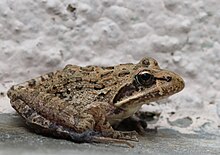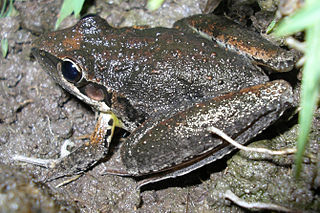
The broad-palmed frog is a species of ground-dwelling tree frog. It is native to much of eastern Australia. They can be found from mid-Queensland to south of Sydney. It is associated with the coast and inland, and is distributed as far west in New South Wales to the South Australia border.
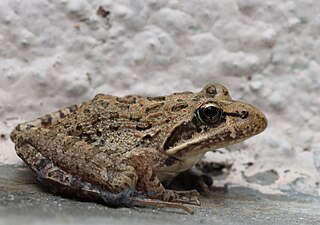
Strongylopus is a genus of pyxicephalid frogs native to Africa. They are found in the area from southwestern South Africa and Namibia to northern Tanzania. Their common name is stream frogs.
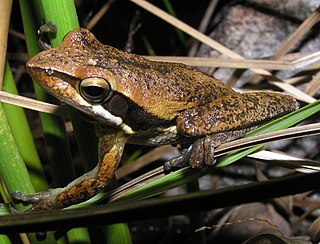
The slender tree frog is a tree frog native to south-western Australia.

Allobates marchesianus, also known as the dull rocket frog, is a species of frog in the family Aromobatidae. It is found in the Amazon Basin in Brazil, Colombia, Ecuador, Peru, and Venezuela. However, this species might represent a cryptic species complex, where at least the populations from Venezuela belong to an undescribed species.
Charadrahyla nephila is a species of frog in the family Hylidae. It is endemic to Mexico and occurs in the Sierra de Juárez and Sierra Mixe in the northern Oaxacan highlands; there is also a questionable record from the Sierra de los Tuxtlas, Veracruz. Prior to its description, it was mixed with Hyla chaneque. The specific name nephila is derived from Greek nephos ("cloud") and philia ("fondness"), referring to the cloud forest habitat of this species. Common name Oaxacan cloud-forest treefrog has been coined for it.
Hyperolius jynx is a species of frog in the family Hyperoliidae. It is endemic to the Rumpi Hills in south-western Cameroon. The common name smooth egg-guarding frog has been proposed for this species.
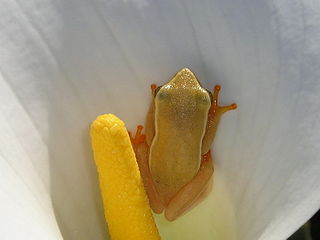
The arum lily reed frog, Horstock's arum-frog, arum lily frog, or Horstock's reed frog is a species of frog in the family Hyperoliidae. It is endemic to South Africa.
Phrynobatrachus uzungwensis is a species of frogs in the family Phrynobatrachidae. It is endemic to eastern Tanzania and is known from the Udzungwa, Uluguru, Nguu, and Nguru Mountains. Common names Ukinga puddle frog and Udzungwa puddle frog have been coined for this species.

Amietia delalandii, also known as the Delalande's river frog, the Drakensberg frog, Drakensberg river frog, or Sani Pass frog, is a species of southern African river frog in the family Pyxicephalidae. It is found in Lesotho, South Africa, Mozambique, Malawi, Zimbabwe, and possibly Zambia. It is the sister species to A. vertebralis.
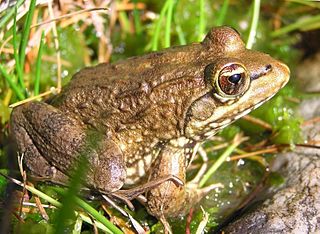
The Cape river frog is a species of frog in the family Pyxicephalidae named for the Cape of Good Hope. Formerly, it was placed in the family Ranidae. It occurs widely in the Eastern Cape and Western Cape provinces of South Africa. A newly described species, A. poyntoni, was split from this species in 2013.

Hildebrandtia macrotympanum is a species of frog in the family Ptychadenidae. It is a rarely seen fossorial frog that is found in southern Ethiopia, Kenya, and Somalia. Common names Somali ornate frog, northern ornate frog, and plain burrowing frog have been proposed for it.
Meristogenys poecilus is a species of frog in the family Ranidae. It is endemic to Borneo and known from between central Sarawak (Malaysia) and central Kalimantan (Indonesia). The specific name poecilus is derived from the Greek poikolos, meaning "pied" or "blotched", in reference to diagnostic pattern on rear of the thigh. Common name Malaysian Borneo frog has been coined for this species.
The Mozambique ridged frog is a species of frog in the family Ptychadenidae. These frogs can swim fairly well, jump far and can crawl with ease through dense plants. Their strong hindlegs can launch them up to three metres into the air in a single bound.
Ptychadena wadei is a species of frog in the family Ptychadenidae. It is endemic to Ethiopia and only known from a small area southeast of Lake Tana, in the upper reaches of the Blue Nile. The specific name wadei honours Edward O.Z. Wade, an English illustrator and herpetology enthusiast who drew some of the illustrations accompanying the species description. Common name Wade's grass frog has been coined for it.
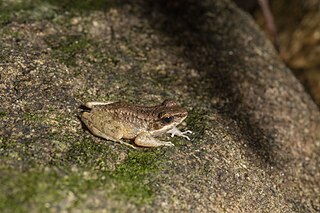
Odorrana utsunomiyaorum is a species of frog in the family Ranidae. It is endemic to Ryukyu Archipelago, Japan, and is known from the islands of Ishigaki and Iriomote, both in the Yaeyama Group. The specific name utsunomiyaorum honours Taeko and Yasuaki Utsunomiya for their contributions to clarifying the amphibian fauna of the Yaeyama Group.

The banded stream frog, also known as the banded sand frog, Cape grass frog, Cape stream frog, long-toed frog, mountain frog or Jonkersberg frog, is a species of frogs in the family Pyxicephalidae. It is endemic to South Africa.

Strongylopus fasciatus, also known as the striped stream frog, striped grass frog, striped rana, striped long-toed frog or long-toed grass frog is a species of frog in the family Pyxicephalidae. It is endemic to southern Africa.
Amietia hymenopus is a species of frog in the family Pyxicephalidae. It is found in the Drakensberg Mountains and Lesotho Highlands in northeastern Lesotho and adjacent South Africa. This species has many common names: Phofung river frog, Berg stream frog, Drakensberg river frog, Natal Drakensberg frog, Drakensberg frog, and Drakensberg rana.
Strongylopus kilimanjaro is a species of frog in the family Pyxicephalidae. It is endemic to Tanzania and only known from a narrow alpine range on the middle slopes of Mount Kilimanjaro, within the East African montane moorlands ecoregion. It is known only from three specimens collected in 1936. The lack of recent records is probably a reflection of very limited survey effort in the area since then.

Amietia desaegeri is a species of frog in the family Pyxicephalidae. It is found west and south of the Rwenzori Mountains in eastern Democratic Republic of the Congo and north-western Rwanda. The common names Byangolo frog and De Saeger's river frog have been coined for it.
